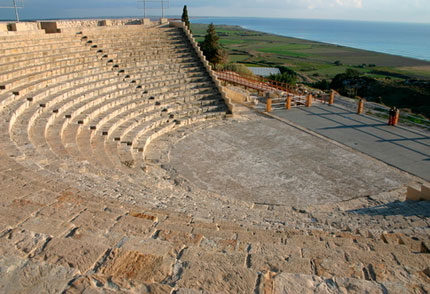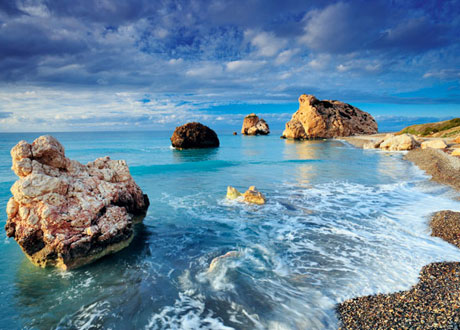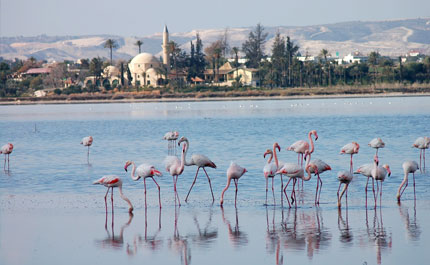Cyprus
Country statistics

Land area: 3,568 sq miles (9,241 sq km)
Total area: 3,571 sq miles ()
Population (2010 est.): 1,102,677 (growth rate: 1.66%); birth rate: 11.3/1000; infant mortality rate: 9.5/1000; life expectancy: 77.6; density per sq km: 85
Capital City: Lefkosia (Nicosia)
Monetary unit: Euro
Languages: Greek, Turkish (both official); English
Ethnicity/race: Greek 77%, Turkish 18% (each concentrated almost exclusively in separate areas); other 5% (2001)
Religions: Greek Orthodox 78%, Islam 18%, Maronite, other (includes Maronite and Armenian Apostolic) 4%
Country introduction

Cyprus is an island country in the Eastern Mediterranean Sea, east of Greece, south of Turkey, west of Syria and Lebanon, north-west of Israel and north of Egypt. Cyprus is the third largest island in the Mediterranean Sea, after the Italian islands of Sicily and Sardinia (both in terms of area and population).
The island consists of two mountain ranges (on the north and south) and a central lowland. The Kyrenia Range lies close to the north coast and consists mainly of limestone. To the south is the Mesaoria Plain, in which the densest population is found. The Mesaoria plain is drained by the Pedieos River, the longest on the island. The southern half of the island is occupied by the rugged Troodos mountains, composed mainly of volcanic rocks. The Troodos Mountains cover most of the southern and western portions of the island and account for roughly half its area. The highest point on Cyprus is Mount Olympus at 1,952 m (6,404 ft), located in the centre of the Troodos range.
The northern and eastern shores of North Cyprus are lapped by the clear, blue, warm waters of the Mediterranean. All along the coastline are bays and beaches where swimming and sunbathing can take place the whole year round. The largest bays are Guzelyurt and Famagusta and main peninsulas are Zafer, Korucam and Kasa.
The culture

The Cypriots are renowned for their friendliness and hospitality. This combination of glorious climate, varied and exciting restaurants, nightlife and a fascinating history make Cyprus an ideal choice for a holiday destination.
Folklore occupies a very important place with the Cypriots, who due to their geographic location, have benefited from a variety of cultures. Greeks, Egyptians, Romans, Byzantines, early Christians, Crusader Knights, Templars, Venetians, Muslims, Turks and the British have all influenced the cultural heritage of this Mediterranean Island. The cultural inheritance of Cyprus includes antiquity stone age settlements, Roman amphitheaters, Egyptian graves, byzantine churches and monasteries, icons, wall paintings and much more. Even now the ancient amphitheaters of Curium outside of Limassol and of Paphos still play concerts.
Apart from the many religious customs and traditions that can be traced back to the origins of Greek Orthodoxy and are evident during Easter, Christmas, The Festival of the Flood (Kataklysmos), Saint Paul's feast and other religious celebrations, there are many more relating to music, dancing and wine. For example the Wine Festival of Limassol takes place every year during the month of September where wine is free flowing for ten to twelve days. Where music and dance are concerned, Cyprus has quite distinct traditions from those of Greece and include traditional Cypriot costumes, dancing face to face or in a group, accompanied by violin or flute music.
Attractions & landmarks

Paphos, is a coastal town in the south-west of Cyprus. In Greco-Roman times Paphos was renowned as the capital of Alexander III of Macedon (Alexander the Great), and it is famous for the remains of the Roman Governor's palace where extensive, fine mosaics are a major tourist attraction. Another famous archaeological site is the Tombs of the Kings, a rock-cut necropolis (burial complex) dating back to the 4th century BCE, where it is thought the wealthy and powerful citizens of the Paphitic community of the time were buried. Also, the famous and impressive monument Paphos Castle can be seen on the outskirts of the city's harbor. This impressive military fort was built as a Byzantine fort to protect the harbour of Paphos, as part of a coastal defense system of Cyprus. Paphos is extremely proud of its ancient past and this includes the fact that it was the birthplace of the Greek Goddess Aphrodite who was the Goddess of love and beauty. Legend has it that Aphrodite emerged from the sea in 1200 BC and chose Aphrodite's Rock as the ideal location to begin her life as a mortal.
Geroskipou village, east of Paphos is where the local shops can be found. The village has a good selection of shops on the main street, selling Turkish Delight (a sweet confection made of jelly) to basket ware and ceramics. Here a unique Byzantine church can be found dating to the 11th Century. It is unique by the fact that it has five domes, inside the church the five domes form a cross. The walls of the church are adorned with ancient paintings and icons, most dating back to the 10th and 15th Century.
The island is filled with numerous museums, including the Cyprus Museum in Nicosia, which holds some of the most beautiful and fascinating collection of Cypriot artefacts and archaeological finds from the Neolithic Age through to the Early Byzantine period. Additionally more of the early culture and settlements of Cyprus can be seen at the Leventis Municipal Museum of Nicosia, while the Byzantine Museum and Art Galleries offers the largest collection of icons on the island, as well as paintings and maps. And the history of the independence movement can be seen at the National Struggle Museum, which includes documents, photos and other artifacts from the 1950s National Liberation Struggle.

Larnaca, a small town on the coast is an enjoyable and pleasant place where a walk along the Larnaca promenade next to the seafront can be enjoyed. There are many things to see in this town like the Church of St. Lazarus and the Larnaca Salt Lake where in the winter season pink flamingos can be seen. Kition Archeological site, one of the most important historic sites can be found in Larnaca. Five temples dated from the 13th and 12th century BC was uncovered here along with a number of other structures.
Cyprus is full of stunning beaches and natural attractions. Ayia Napa, a small town located in the south-east of Cyprus, is famous for some of the most beautiful beaches in the Mediterranean and in the whole world. The sand is white and the waters are crystal clear. The most beautiful and popular beach is Nissi, located in a small picturesque bay in the west of Ayia Napa. The coral reefs near Ayia Napa are a place where underwater life is blooming. Other great Cyprus beaches include Alagadi Turtle Beach, Protaras Beach, Curium Beach, Ladies' Mile Beach, Pissouri Beach and Governor's Beach.